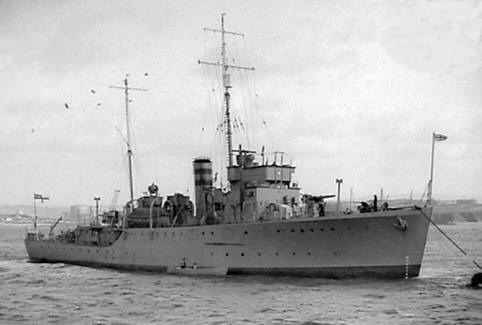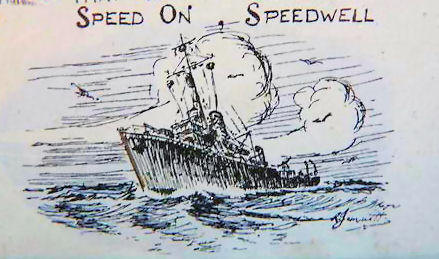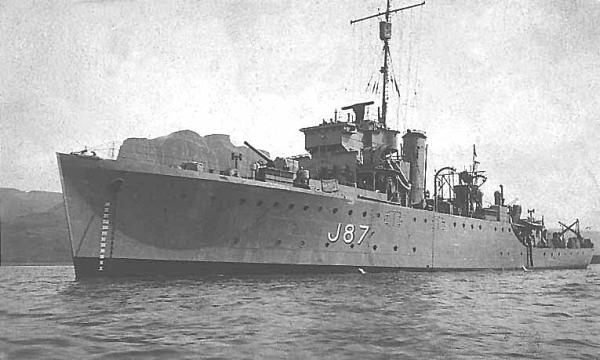
HMS Speedwell
Summary of History
HMS SPEEDWELL (J87) completed on 30 September 1935 and joined
the 1st Minesweeping Flotilla, attached to the Mediterranean Fleet, and
was based at Alexandria. She returned to Devonport for a refit which was
completed at the end of June. She stayed in home waters undergoing a
further refit at Devonport in early 1937 until July of 1937, when she
left for the Mediterranean. Returning to the UK at the end of 1937,
SPEEDWELL was undergoing repairs, refit and re‑arming at
Devonport, until the end of April 1938. In July of the same year, she
was at Sheerness, and placed in reserve, where she remained until, with
the outbreak of the Second World War was re‑commissioned on 30 September
1939.
On re-commissioning, HMS SPEEDWELL joined the 5th
Minesweeping Flotilla working off the East Coast. While sailing with
this flotilla off Cromer, on 21October 1939, an enemy aircraft attacked
one of the ships in company; there were no casualties.
In February 1940, HMS SPEEDWELL, together with HM Ships
SPHINX and SKIPJACK, was sweeping north of Kinnaird Head. SPHINX was
attacked by an enemy aircraft and heavily damaged; SPEEDWELL took
her in tow, and after the tow parted made repeated efforts to go
alongside before the SPHINX finally sank.
SPEEDWELL took an active part in Operation 'Dynamo' ‑ the
evacuation from Dunkirk between 27 May and 4 June 1940, SPEEDWELL
brought 1,668 officers and men back to England, sustaining extensive
damage by enemy action in the process.
During June 1941, a ship in an Atlantic convoy
SPEEDWELL was escorting was torpedoed; SPEEDWELL searched for the
submarine responsible, gained a contact, and released 5 depth charges.
The contact was lost twice, re‑obtained and further depth charges
dropped, but without any visible result. As the escorts were about to
conduct a second sweep, an enemy submarine was sighted surfacing. Owing to
SPEEDWELL's limited speed, she did
not arrive on the scene until after the enemy had been sunk by the
remainder of the searching party. The submarine concerned was U‑651, and
the entire crew, including the Commanding Office were rescued and taken
prisoner.

In 1942
SPEEDWELL took part in 'Operation Anklet', the raid on the Lofoten
Islands; then escorted Russian convoys. SPEEDWELL's Commanding
Officer, Lieutenant Commander J J Youngs, OBE, RNR, one officer and a
rating were mentioned in despatches for devotion to duty while salvaging HARMATRIS.
As part of the escort for another Russian convoy, HMS
SPEEDWELL left ??? on 10 April 1942. On 11 April the convoy was
attacked five times by enemy aircraft, two of which were shot down and
several others damaged. On ??? June, SPEEDWELL picked up 37 survivors
from the Russian ss KIEV, which had been torpedoed. Enemy aircraft again
attacked the convoy and four were shot down. A U-boat was spotted
running on the surface attempting to attack the destroyer HMS MARNE. HMS
SPEEDWELL opened fire on the enemy, forcing him to break off the attack
and dive. SPEEDWELL first attempted to ram the submarine without
success; she then turned and attacked with depth charges. Four charges
were dropped by SPEEDWELL before the MARNE followed with a larger
attack. The two ships circled the position, observing a large patch of
oil on the surface. SPEEDWELL parted company from the convoy on 18
April and proceeded to Hvalfjord, Iceland.
Later in 1942 SPEEDWELL escorted a convoy to Gibraltar,
then operated off the North African coast where she went to the
assistance of the fast minelayer MANXMAN which had been torpedoed. In
May 1943 HMS SPEEDWELL was involved in Operation 'Antidote', a
minesweeping operation in the Mediterranean, off the coast of Tunisia,
which had just been cleared of enemy forces. For the work performed by
his ship in this operation, SPEEDWELL's Commanding Officer, Lieutenant
Commander T E Williams, RD, RNR, was awarded the DSC. Later in May 1943,
HMS SPEEDWELL returned to the UK and was based at Leith during the
summer.
In September 1943 she relieved HMS BRITOMART, working in
North Russian waters until February 1944. While escorting the US tanker
CULPEPPER on 25 October 1943, SPEEDWELL ran aground off Akureyri. No
damage was caused and both ships arrived at Hvalfjord ??? later.
On return, SPEEDWELL joined 1st MSF working
off the east coast. During the assault phase of the invasion of Normandy
on 6 June 1944, SPEEDWELL was one of the vessels which swept a channel
for Force 5, the naval force which covered the landing at Ouistreham.
She afterwards assisted in keeping mines out of the swept channels for
the passage of troops, munitions and supplies to the Allied Armies.
For the remainder of the war, HMS
SPEEDWELL continued to
carry out minesweeping duties between Harwich and the Continent,
latterly clearing the route to Hamburg and in the Heligoland Bight. At
the end of 1945 she was reduced to the reserve at Chatham and laid up at
Harwich. On 5 December 1946 she was sold and became the merchant vessel
TOPAZ, registered at Antwerp. Whilst en route to the Dutch ship breakers
on 11 May 1954, she was wrecked (?) and later scrapped at Dordrecht.


